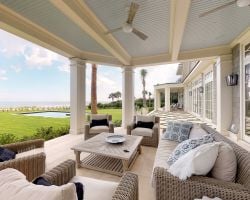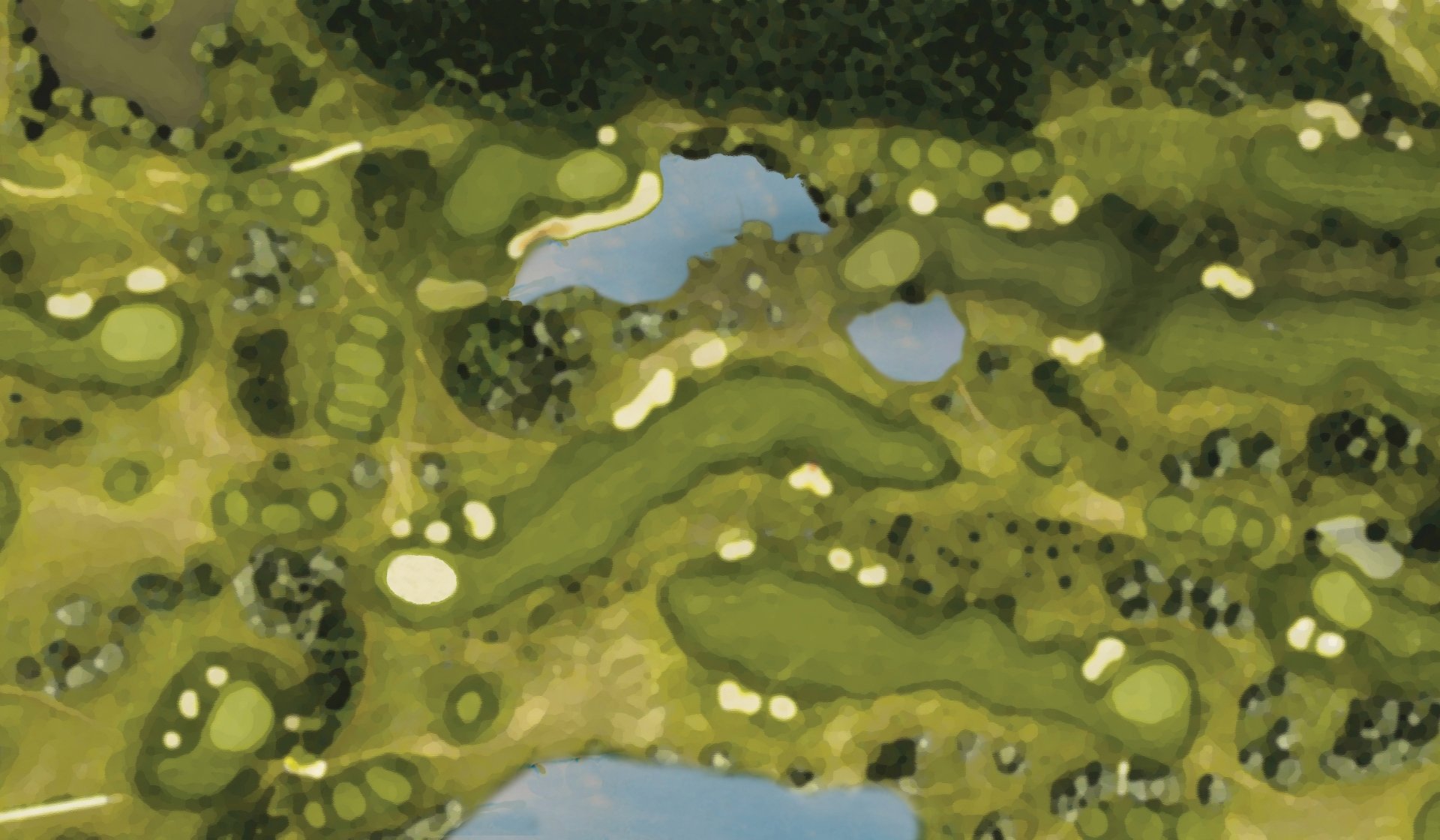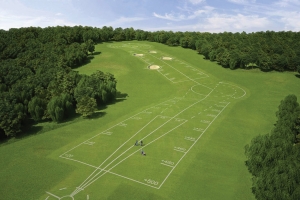The Groundwork For Golf
From initial planning to the first tee shot, golf course architects strive to highlight natural beauty into a memorable playing experience.
The philosophy behind golf architecture has remained constant for centuries: Build a course that maximizes the land’s natural beauty and tantalizes players with its gameplay. To get there, legendary sportswriter Herbert Warren Wind once noted, a golf architect needs to have “the soul of an artist, the brain of an engineer and the heart of a golfer.” Today’s golf course designers can attest that truer words have never been spoken. “Every golf course that’s worth its name is a function of the land upon which it’s situated,” says renowned golf course architect Robert Trent Jones Jr., who has designed more than 280 golf courses in over 45 countries on six continents throughout his career. An architect’s initial exploration of terrain generally takes place on foot. “You want to feel the land through the soles of your feet, because they are as important to design as your hands and eyes,” Jones explains.
A topographic map helps guide decisions as far as the borders, boundaries and access to the clubhouse. Depending on the project, design factors to consider may include whether the plan is a standalone golf course or if the course is situated among homes or commercial developments. But a golf course architect also needs to know what lies below the surface, as far as the water source, soil types and mechanics, natural drainage channels and irrigation routing options. “It’s a bit like surgery, in that you want to know what you’re going to find before you open it up,” Jones explains.
Beyond recreation, a golf course plays an important role in managing water — capturing and slowing it down before it leaves a property. “From the first step till the finished product, a lot of elements come into play that golfers may not recognize,” notes Phil Smith, whose career includes work with Jack Nicklaus and the late Tom Weiskopf before starting his own Phil Smith Design brand in 2012.
FROM PENCIL AND PAPER TO DIRT
Although newer generations may go straight to their laptop and create a computer-based design, both Jones and Smith still draft the initial layout on paper. “A college professor once told me that great architects design through their own fingers with a number six pencil,” maintains Jones, who starts the process by marking up the waterways on the topographic map and then lays out the tees, fairways and greens like a puzzle around them to follow the contours of the land. For the final step of design, Jones still prefers to go into the field to sketch out his vision.
During this process, the architect is taking into consideration — along with the input from owners or developers — a wide-ranging number of stylistic factors that go beyond the links. Will there be returning nines? Separate tee boxes or long runway tee boxes? Do the longest par fours and fives go in opposite directions, and are all par threes in different directions to give it design variety in varying wind conditions? Are the hazards, whether bunkers, water or woods, balanced on the left and right sides of the course?
A hands-on architect remains involved throughout the construction process, an endless stream of milestones and approvals on shaping, drainage and features, with lots of iterations. Once the irrigation is in, that’s when detail matters most. “On the green surfaces, I’m looking at details within a quarter of an inch, which can make a huge difference,” Smith explains.
With the layout complete, the grass selection is perhaps the most local decision; after all, New England’s cold winters and ice are a completely different environment from, say, Hawaii. Once a hole has been seeded, it’s usually about a three-month grow-in before it’s ready to open, and about three months from the time the last hole is finished to opening the course. Using sod can help accelerate the process, while minimizing chemical use and erosion, but it will also add more to the construction budget.
THE ARCHITECT’S PERSPECTIVE
At the end of the day — or the round — golfers may have their own favorite designers, but the architects have opinions of their own on how they’d like to be viewed.
When encountering Jones after playing one of his designs, many golfers will share tales about their favorite hole on a given course or the least favorite that caused them to card a double bogey. “The point is, I thank every one of them,” Jones shares. “First, for recognizing, as an artist, that I have engaged them to the point they have a point of view. More importantly, I appreciate the fact they’re passionate about it. If I can be creative to the point where I’ve evoked an emotion, to me, that’s my psychic reward.”
Smith prides himself on building a balance of tough, challenging holes with others that provide options for the higher handicap. “It’s always my hope that if 18 people played a course I designed, they’d each have a different favorite hole,” he notes. “What I enjoy is when people play a course and come off smiling, then want to run back right back in the pro shop and play another round.”
MAXIMIZING PLAYABILITY AND BEAUTY
Even the best-designed layouts require a refresher every two decades or so to keep the course in top playing condition. The Plantation Course at Sea Island has gone through several updates over the decades and most recently reopened in 2019 after a complete redesign by Davis Love III and his brother, Mark, of Love Golf Design. The refresh draws on the golden age of golf architecture, with influences including Seth Raynor, Charles Blair Macdonald, Donald Ross and Walter Travis, the original architect at Sea Island.
Bunkering was decreased from about 250,000 square feet to about 90,000, and steep, flash-face bunkers were replaced with flat-bottom bunkers, which are easier for players to get in and out of — and less of a maintenance challenge. Among the other major changes were the greens complexes, which are larger, offer a wider variety of pin placements and include features such as a thumbprint on the 11th hole. Golfers now find the Principal’s Nose on the No. 10 green and a few of Travis’ chocolate drops here and there, along with views of the ocean.
“The word that I hear most often from our members and guests is that it’s a fun golf course to play,” states Brannen Veal, director of golf at Sea Island Golf Club. “It’s challenging but it doesn’t beat you up, and Mark and Davis figured out a way to make it visually more memorable.”
Throughout 2023, the course at Ocean Forest Golf Club on Sea Island is receiving a refresh of its own. The private club was purpose-built in 1995 to hold championships, and it has lived up to that as the host of the Walker Cup in 2001 and the annual Jones Cup Invitational since then.
The remodel will balance testing the skills of elite ball-strikers while making it enjoyable for a wider swath of players.
The planned changes will create larger, less elevated, but more-contoured greens that will demand precise approach shots for players looking to score. Adjustments to the undulating greens will also include more playable space surrounding the putting surfaces with fewer bunkers and short-cut grass in the surrounds to promote creative recovery options. Many of the holes will add new forward tees, while others will back up the tips to accommodate ever-longer hitters.
Beau Welling of Beau Welling Design says: “Being a challenging test of golf has always been a big part of the DNA of Ocean Forest. The site itself is already so magnificent, with spectacular live oak trees and holes along the Atlantic Ocean and Hampton River.”
The course refresh at Ocean Forest began in February 2023 and will continue into early fall. The course is expected to be ready for play by the end of 2023.






